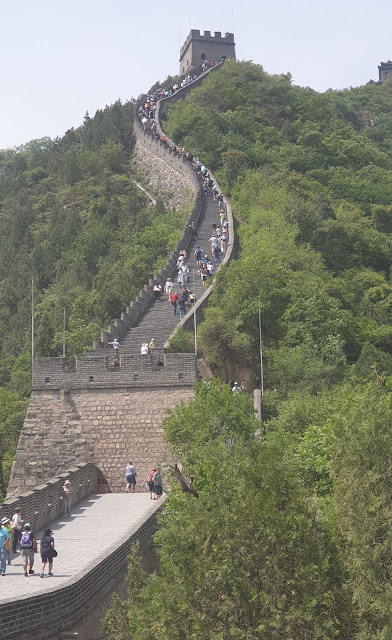The Great Wall of China
After visiting the jade factory we take a scenic drive through the countryside and mountains to reach China’s most renowned monument—the Great Wall.
We were visiting the less-touristy and more original Juyong Pass, avoiding other sections which are the most accessible and consequently most crowded.
From a short discussion on the bus while traveling to this destination we learn the Great Wall meanders through China’s northern mountain ranges from the Yellow Sea to the Gobi Desert - the original wall's actual distance was about 21,196 km or 13,170 miles.
Currently, it is about 8,850 km or 5,500 miles, 6 to 7 meters high, 20 to 23 feet. The average width is about 6.5 meters or 21.3 feet. Though originally the wall was started 2,700 years ago, the sections set aside for visitors are between 400 to 600 years old.
And the wall isn't just a wall, it had a host of other fortifications such as overlapping walls, trenches, watchtowers and beacon towers for communications, fortresses, and barracks to accommodate soldiers.
We were visiting the less-touristy and more original Juyong Pass, avoiding other sections which are the most accessible and consequently most crowded.
From a short discussion on the bus while traveling to this destination we learn the Great Wall meanders through China’s northern mountain ranges from the Yellow Sea to the Gobi Desert - the original wall's actual distance was about 21,196 km or 13,170 miles.
Currently, it is about 8,850 km or 5,500 miles, 6 to 7 meters high, 20 to 23 feet. The average width is about 6.5 meters or 21.3 feet. Though originally the wall was started 2,700 years ago, the sections set aside for visitors are between 400 to 600 years old.
And the wall isn't just a wall, it had a host of other fortifications such as overlapping walls, trenches, watchtowers and beacon towers for communications, fortresses, and barracks to accommodate soldiers.
This is in a very scenic area and on the first impression; it is absolutely stunning in concept and in viewing.
As for the idea of walking on it, well, that first view of the mountain climb when getting off the bus, my first question was where the elevator is? Sorry, there is none. It's walk on up or stay down the bottom.
Walk it is. As far as you feel you are able. There are quite a few who don't make it to the top. I didn't. I only made it to the point where the steps narrowed.
But as for the logistics, there's the gradual incline to the starting point, and what will be the end meeting place. From there, it's a few steps up to the guard station no 7, and a few more to get up to the start of the main climb. The top of the wall is guard station no 12.
Ok, those first few steps are a good indication of what it’s was going to be like and it's more the awkwardness of the uneven heights of the steps that's the killer, some as high as about 15 inches. This photo paints an illusion, that it’s easy. It’s not.
If you make it to the first stage, then it augers well you will get about 100 steps before you both start feeling it in your legs, particularly the knees, and then suffering from the height if you have a problem with heights as the air is thinner. And if you have a thing with heights, never look down.
This was from where we stopped, about a third of the way up. The one below, from almost at the bottom. One we’re looking almost down on the buildings, the other, on the same level.
It requires rest before you come down, and that's when you start to feel it in the knees, our tour guide called it jelly legs, but it's more in the knees down. Descending should be slow, and it can be more difficult negotiating the odd height steps, and particularly those high ones. You definitely need to hang onto the rail, even try going backward.
And, no, that rail hasn't been there as long as the wall.
While you are waiting for the guide to return to the meeting place at the appointed time, there should be time to have some jasmine tea. Highly refreshing after the climb.
Lunch, today, is included, back at the jade factory
It is also a restaurant, and here we are being served Australia Chinese dishes that lean towards Chinese cuisine, but, it's definitely not authentic Chinese food.
I won't say it's disappointing because it tastes delicious, but I think it would have been more important to continue the Chinese experience. Maybe that will come with the Hutong tour, which will be tonight.
With dinner included this should be the authentic Chinese food.






No comments:
Post a Comment